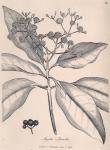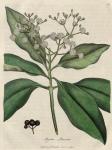026. Myrtus pimenta. Pimento, Jamaica Pepper, All-spice.

 Synonyma. Pimento. Pharm. Lon.
Synonyma. Pimento. Pharm. Lon.
Pimenta & Piper Jamaicensis. Pharm. Ed.
Caryophyllus aromaticus Americanus, Lauri acuminatis foliis, fructu orbiculari. Pluk. Phyt. 155. f. 4.
Amomum quorundam odore Caryophylli, J. B. Caryophyllus aromaticus fructu rotundo, Caryophyllon Plinii. Bauh. Pin.
Piper adoratum Jamaicense nostratibus. Raii Hist. 1507.
Myrtus arborea aromatica foliis laurinis. Sloane's Jam. vol. 2. p. 76.
Caryophyllus foliis oblongo-ovatis glabris alternis, racemis terminalibus et lateralibus. Browne's Jam. p. 247.
Caryophyllus foliis lanceolatis oppositis, floribus racemosis terminalibus & axillaribus. Miller's Dict.
Class Icosandria. [Some of these trees are frequently observed to be barren, which has introduced a notion among the people of Jamaica of their being male and female trees in general; and that some of the male or barren trees were necessary in every walk; which, as they are commonly many, is a vast detriment. It is however certain, that all those I have observed were hermaphrodites: and I am credibly informed, that those they call males, when lopped and broke like the rest for one or two years, do bear very well: which I am the more apt to believe, as I have never observed a distinct male or female flower on any of them." Browne, l. c.] Ord. Monogynia. Lin. Gen. Plant. 217.
Ess. Gen. Ch. Cal. 5-fidus, superus. Petala 5. Bacca. 2. s. 3-sperma.
Spec. Char. M. floribus trichotomo-paniculatis foliis oblongo-lanceolatis. Hort. Kew.
Varietates,
α foliis oblongo-lanceolatis acuminatis; acumine obtuso.
β foliis ovalibus obtusis. Hort. Kew.
This handsome myrtle grows above thirty feet in height, and two in circumference; the branches near the top are much divided, and thickly beset with leaves, which by their continual verdure always give the tree a beautiful appearance; the bark is very smooth, externally, and of a grey colour; the leaves vary in shape, and in size, but are commonly about four inches long, veined, pointed, elliptical, and of a deep shining green colour; the flowers are produced in bunches, or panicles, and stand upon subdividing or trichotomous stalks, which usually terminate the branches; the calyx is cut into four roundish segments; the petals are also four, white, small, reflex, oval, and placed opposite to each other between the segments of the calyx; the filaments are numerous, longer than the petals, spreading, of a greenish white colour, and rise from the calyx and upper part of the germen; the anthers are roundish, and of a pale yellow colour; the style is smooth, simple, and erect; the stigma is obtuse; the germen becomes a round succulent berry, containing two kidney-shaped flattish seeds. This tree is a native of New Spain and the West-India islands. In Jamaica it grows very plentifully, and in June, July, and August puts forth its flowers, which, with every part of the tree, breathes an aromatic fragrance. ["The leaves and bark are full of aromatic particles, which make them (the planters) extremely cautious of fire in all Pimento walks; where, if it should once catch, it runs with great fury." Browne, l. c.]
The Pimento tree was first introduced and cultivated in this country by Mr. Phil. Miller in 1739, and the figure we have annexed was drawn from a recent specimen, obtained from the garden of his Grace the Duke of Northumberland at Sion-House, where the plant is now in full bloom. Pimento, or the berries of this species of myrtle, are chiefly imported into England from Jamaica, and hence the name Jamaica Pepper. It is also named All-spice from its taste being supposed to resemble that of many different species mixed together. When the berries arrive at their full growth, but before they begin to open, ["Such of the berries as come to full maturity do, like many other seeds, lose that aromatic warmth for which they are esteemed, and acquire a taste perfectly like that of Juniper berries, which renders them a very agreeable food for the birds, the most industrious planters of these trees." Browne, l. c. "The berries when ripe are of a dark purple colour, and full of a sweet pulp, which the birds devour greedily, and muting the seeds, afterwards propagate these trees in all parts of the woods. It is thought that the seeds passing through them, in this manner, undergo some fermentation, which fits them better for vegetating than those gathered immediately from the tree; and I believe this is the fact." Long's Jamaica, vol. 3. p. 703.] they are picked from the branches, and exposed to the sun for several days, till they are sufficiently dried; this operation is to be conducted with great care, observing that on the first and second day's exposure they require to be turned very often, and always to be preserved from rain and the evening dews. After this process is completed, which is known by the colour and rattling of the seeds in the berries, they are put up in bags or hogsheads for the market. This spice, which was at first brought over for dietetic uses, has been long employed in the shops as a succedaneum to the more costly oriental aromatics; "it is moderately warm, of an agreeable flavour, somewhat resembling that of a mixture of cloves, cinnamon,and nutmegs. Distilled with water it yields an elegant essential oil, so ponderous as to sink in the water, in taste moderately pungent, in smell and flavour approaching to oil of cloves, or rather a mixture of cloves and nutmegs. To rectified spirit it imparts, by maceration or digestion, the whole of its virtue: in distillation it gives over very little to this menstruum, nearly all its active matter remaining concentrated in the inspissated extract.
Pimento can scarcely be considered as a medicine: it is, however, an agreeable aromatic, and on this account is not unfrequently employed with different drugs, requiring such a grateful adjunct. Both the Pharmacopoeias direct an aqueous and spirituous distillation to be made from these berries, and the Edinburgh College order also the Oleum essentiale piperis Jamaicenfis.

